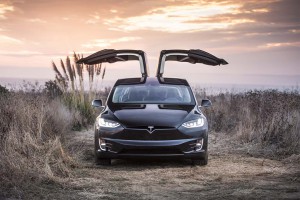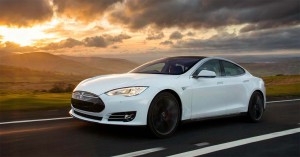
Tesla fell short of its goal of delivering 80,000 vehicles in in 2016, but only narrowly as it produced nearly 77,000 vehicles.
Tesla ended 2016 with some good news … and some bad.
The California EV maker said it delivered a total of 76,230 vehicles last year, but it still fell short of its goal of handing customers the keys to 80,000 vehicles for the year. That said, production was up a full 64% in 2016, in part due to the ramp-up of the all-new Model X battery-SUV.
Put the blame for the sales shortfall on the updated Tesla Autopilot system. Since October, Tesla has been adding a variety of new sensors to both the Model X and the Model S sedan to give those cars advanced, semi-autonomous capabilities. But the changeover caused initial problems slowing production early in the fourth quarter.
So, while the company was “ultimately able to recover” Q4 production, it was “weighted more heavily towards the end of the quarter than we had originally planned,” the company explained in a statement.
And by the time cars got onto carriers and into showrooms, the year was over. For Q4, deliveries came in at 22,200, totally accounting for the full year’s 3,000 vehicle shortfall.
(Nissan’s Ghosn to reveal plans for updated Leaf, autonomous vehicles. Click Here for the story.)

Tesla's updates for the new version of Autopilot slowed production levels for the maker, causing it to miss its 2016 sales goal.
Tesla is nonetheless hoping that the update of the Autopilot system will increase the appeal of its vehicles – and offset the image hit the maker took in the wake of reports about a fatal May crash involving the technology. Several other incidents have been linked to the technology, though it has not yet been confirmed if Autopilot actually deserves blame.
The revised system replaces the camera-based technology Tesla originally used with more advanced radar and other sensors.
On New Year’s Day, Tesla began upgrading and activating software expanding the functionality of the new Autopilot hardware, and it promises to add even more features going forward.
For the full year, the production story was actually solid for Tesla. In the fourth quarter alone, it built 24,882 vehicles, with total 2016 production at 83,922 vehicles, up 64% compared with 2015.
(Click Here for more about the first three owners taking delivery of their new Chevy Bolts.)
There is an asterisk to those figures. Tesla early on had hoped to boost production to somewhere short of 1,800 vehicles a week, or as much as 90,000 for the year. It early in 2016 had to revise that figure downward, however, because of production problems with the Model X, especially with the distinctive, if trouble-plagued “falcon doors.”
The Model X has faced significant quality issues, much of it involving those upward-opening portals, and enough so that influential Consumer Reports magazine had to warn readers about the battery-electric SUVs reliability problems. CR also noted, however, that Tesla had been effectively addressing quality issues with the older Model S.
The new year will bring still more challenges for Tesla. It plans to begin rolling the new Model 3, its first mainstream model, down the assembly line, with sales set to begin sometime during the second half of 2017, according to CEO Elon Musk.
Since the 200-mile sedan was unveiled on March 31, Tesla has taken about 400,000 advance registrations, each requiring a refundable $1,000 deposit.
(To see more about Tesla’s Autopilot update, Click Here.)
But while Musk has insisted Tesla will make its production launch target, the company has a poor history of coming in on time, the Model X running two years behind schedule. Analysts worry that if the Model 3 is much delayed, potential buyers could begin asking for their money back and go looking at alternatives such as the new Chevrolet Bolt EV. That 238-mile range battery-car is slightly lower-priced than the Model 3, starting at under $30,000 after factoring in the $7,500 federal tax credit.
